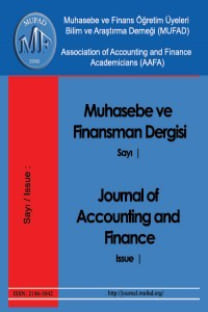Uluslararası Kamu Sektörü Muhasebe Standartları (IPSAS): Genel Bakış ve IFRS’lerden Farklılığı
Devlet Muhasebesi, IPSAS, IPSASB, IFRS
___
- AASB (2015), AASB 123 BorrowingCosts, https://www.aasb.gov.au/admin/file/content 105/c9/AASB123_08-15.pdf (Erişim Tarihi: 26.02.2019)
- AASB (2018),TheAASB’sApproachto International PublicSector Accounting Standards. https://www.aasb.gov.au/admin/file/content105/c9/ITC41_08-18.pdf (Erişim Tarihi:26.02.20 19)
- ACCA (2017),The Association of Chartered Certified Accountants IPSAS implementation: CurrentStatusandChallenges, https://www.accaglobal.com/content/dam/ACCA_ Global/Technical/pubsect/pi-IPSAS-implementation-current-status-and-challenges.pdf(Erişim Tarihi:26.02.2019)
- Aggestam-Pontoppidan, C.,Anderneck, I. (2015),Interpretationand Application of IPSAS, John Wiley&Sons
- Arslan A.(2011), Kamu Sektörü Uluslararası Muhasebe Standartları ve Türkiye Uygulaması. https://www.dunya.com/gundem/kamu-sektoru-uluslararasi-muhasebe-standartlari-ipsasvetur kiye-haberi-156501 (Erişim Tarihi: 11.05.2018)
- Bellanca, S.,Vandernoot, J. (2013), “Analysis of BelgianPublic Accounting andItsCompliancewith International PublicSector Accounting Standards (IPSAS) 1, 6 and 22”, International Journal of Business and Management, 8(9).doi:10.5539/ijbm.v8n9p122
- Bergmann, A.,Fuchs, S. (2017),“Accounting StandardsforComplexResources of International Organizations”, Global Policy, Volume 8, Issue S5, p-26-35
- Besteliu, N., E. (2018), “Ways of takingoverandoperationalizingthe International PublicSector Accounting Standards (IPSAS) – Essentialmilestones in thisprocess”,https://search.proquest.com/docview/2043180894/fulltextPDF/1CEE9ED6AAAB4EAFPQ/1?accountid=15426(Erişim tarihi:21.01.2019)
- Christiaens, J.,Vanhee, C., Rossi ,F. M., Aversano, N., Cauwenberge, P. (2015), “Theeffect of IPSAS on reforminggovernmentalfinancialreporting: an internationalcomparison”, International Review of AdministrativeSciences, Vol. 81(1) 158–177, p.166
- CzechRepublicSupremeAudit Office (2018),PressRelease.https://www.nku.cz/en/for-media/press-releases/international-accounting-standards-2016-are-translated-into-czech--thanks-to-the-sao-and-other-professionals-id9522/(Erişim Tarihi: 22.01.2019)
- DMSK(2018),TurkishPublic Accounting Reform &Harmonization of International Standards.http://www.dmsk.gov.tr/upload/Turkish%20Public%20Accounting%20Reform21 %2002%202018.pdf (Erişim Tarihi: 26.02.2019)
- Deloitte (2017), IPSAS in your Pocket, s 6. https://www.iasplus.com/en/publications/public-sector/ipsas-in-your-pocket-2017 (Erişim Tarihi: 15.01.2019)
- ErnstandYoung (2012),Overviewandcomparison of publicaccountingandauditingpractices in the 27 EU MemberStates ,PreparedforEurostat, Final Report, p.78 https://ec.europa.eu/eurostat/documents/1015035/4261806/study-on-public-accounting-and-auditing-2012.pdf/5ad43e2b-2ba7-4b05-afab-d690fc2ad9dd (Erişim Tarihi: 15.01.2019)
- ErnstandYoung (2013), A snapshot of GAAP differencesbetween IPSAS and IFRS. https://www.ey.com/Publication/vwLUAssets/GAAP_differences_between_IPSAS_and_IFRS/$FILE/IPSAS_vs_IFRS_AU1506.pdf (Erişim Tarihi: 15.01.2019)
- ErnstandYoung (2017), Collection of additionalandupdatedinformationrelatedtothepotentialimpacts of EPSAS, EPSAS WorkingGroup. https://ec.europa.eu/eurostat/documents/64157/4375784/European+Public+Sector+Accounting+Standards+%28EPSAS%29/33209095-65b3-4c80-8b94-10c9a76aec9c (Erişim Tarihi: 15.01.2019)
- EUROSAT (2018),https://ec.europa.eu/eurostat/web/government-finance-statistics/excessive-deficit-procedure/edp-notification-tables (Erişim Tarihi: 15.01.2019)
- Feschiyan, D. (2010),“International PublicSector Accounting Standards in Bulgaria”, Paperpresented at 2nd BalkansandMiddle East Countries Conference on Auditing and Accounting History, Conference Proceedings, Vol. II p. 1557.
- Fisher, L. (2018).“EuropeanCountries on thepathto IPSAS”, International edition of Accounting and Business magazine. https://www.accaglobal.com/in/en/member/ member/accounting-business/2018/03/insights/european-ipsas.html (Erişim Tarihi: 15.01.2019)
- Giuseppe G., Sara Giovanna Mauro & Jarmo Vakkuri (2018), “Converginganddivergingpressures in PBB development: theexperiences of FinlandandSweden”, Public Management Review, 20:12, pp.1836-1857, DOI: 10.1080/14719037.2018.1438500
- Gökçen, G. (2003), Devlet Muhasebesi: Teori Uygulamalar ve Öneri, Türkmen Kitabevi, İstanbul
- IPSASB (2006), IPSAS 1 Presentation of Financial Statements. https://www.ifac.org/system/ files/publications/files/ipsas-1-presentation.pdf, (Erişim Tarihi: 15.07.2018).
- IPSASB (2014a), A CloserLook at: Switzerland, https://www.ifac.org/system/files/ uploads/IPSASB/IPSASB-A-Closer-Look-At-Switzerland2.pdf (Erişim Tarihi: 15.01.2019)
- IPSASB (2014b), A CloserLook at: Malta, https://www.ifac.org/system/files/uploads/ IPSASB/A-Closer-Look-at-Malta.pdf (Erişim Tarihi: 15.01.2019)
- IPSASB (2011),Key Characteristics of the Public Sector with Potential Implications for Financial Reporting Exposure Draft. https://www.ifac.org/system/files/publications/exposure-drafts/IPSASB_ED_Key-Characteristics-of-Public-Sector.pdf (Erişim Tarihi: 03.11.2018)
- IPSASB (2014a), A Closer Look at: Switzerland, https://www.ifac.org/system/files/ uploads/IPSASB/IPSASB-A-Closer-Look-At-Switzerland2.pdf (Erişim Tarihi: 15.01.2019)
- IPSASB (2014b), A CloserLook at: Malta, https://www.ifac.org/system/files/uploads/ IPSASB/A-Closer-Look-at-Malta.pdf (Erişim Tarihi: 15.01.2019)
- IPSASB (2018a),IPSAS AdoptionandImplementation.https://www.ipsasb.org/adoption-and-implementation (Erişim Tarihi: 03.11.2018)
- IPSASB(2018b),International PublicSector Accounting Standards Board https://www.iasplus.com/en/resources/global-organisations/ipsasb.(Erişim Tarihi: 02.11.2018)
- IPSASB (2018c),Handbook of International PublicSector Accounting Pronouncements Volume III, International Federation of Accountants, New York.
- IPSASB (2018d), IPSAS 41 Summary—Financial Instruments. https://www.ifac.org/system/files/publications/files/IPSAS-41-Financial-Instruments-At-a-Glance.pdf (Erişim Tarihi: 26.02.2019)
- IPSASB (2019), IPSAS - IFRS Alignment Dashboard March 2019. https://www.ifac.org/system/files/uploads/IPSASB/Agenda%20Item%201.7%20IPSAS%20IFRS%20Alignment%20Dashboard_March%202019%20-%20revised%20%281%29.pdf (Erişim Tarihi: 31.03.2019)
- Jorge S., (2015),Public Sector Accounting and Auditing in Portugal içinde: Public Sector Accounting Edited by Brusca I., Caperchione, E., Cohen, S., Rossi F. M., Public Sector Accounting and Auditing in Europe: The Challenge of Harmonization, p.173-186
- Karaarslan, E. (2004), Ülkemizde Devlet Muhasebesinin Serüveni. Sayıştay Dergisi, 54.
- Karaarslan, E. (2005), Devlet Muhasebesi Olgusu ve Ülkemizde Devlet Muhasebe Standartları, TÜRMOB Yayınları, Ankara
- OECD(2012), Report to the Swedish Government: Comparison with international accounting standards etc., p.7, https://www.oecd.org/gov/budgeting/Sweden%20-%20ESV%20report.pdf(Erişim Tarihi: 15.01.2019)
- Otrusinava, M.,Pastuszkova, E. (2013),“Trans for mation process of state accounting to accrual basis accounting in conditions of the Czech Republic”,Acta Universitatis Agriculturae et Silviculturae Mendelianae Brunensis, 2013, LXI, No. 7, pp. 2593–2602
- Polzer, T.,Grossi, G., Reichard, C. (2017),“Adoption of IPSAS in National Accounting Reforms. Country specificReactionsto Global Accounting Standards in SelectedEuropeanCountries”, Paperfor Panel G1 at the 21. IRSPM Conference, Budapest, Abstract, p. 13
- Polzer,T.,Meyer, R., Höllerer, M., Seiwald, J., (2016),“Institutional Hybridity in Public Sector Reform: Replacement, Blending, or Layering of Administrative Paradigms”,Research in the Sociology of Organizations, 48B, 69-99
- PSAB (2011), ConsultationPaper - Characterictics of PublicSectorEntities, http://www.frascanada.ca/standards-for-public-sector-entities/documents-for-comment/item52207.pdf (Erişim tarihi 03.12.2018)
- Yanık, S. S. ve Öztürk, C. (2018), “Devlet Muhasebesinde Muhasebe Sistemleri Ve Tam Tahakkuk Sisteminin DMS 1 – Mali Tabloların Sunulması Standardı Açısından Değerlendirilmesi”, Muhasebe Bilim Dünyası Dergisi, 20 (Özel Sayı), ss.1007-1029
- ISSN: 2146-3042
- Yayın Aralığı: 4
- Başlangıç: 2005
- Yayıncı: Muhasebe ve Finansman Öğretim Üyeleri Derneği (MUFAD)
Basılı Ulusal Ve Uluslararası Yönetim Muhasebesi Kitaplarının Değerlendirilmesi
Maliyet Fonksiyonun Belirlenmesinde Yapay Sinir Ağı Modellerinin Kullanımı
Marka Değeri ile Kârlılık İlişkisi Üzerine Bir İnceleme: Hirose Yöntemi ve Panel Nedensellik Analizi
Muhasebe ve Finans Okuryazarlığı: Karşılaştırmalı Bir Çalışma
Murat KARAHAN, Arzu Buse AYVALIOĞLU
Ümit GÜCENME GENÇOĞLU, Yusuf KURT
UFRS ve Çeviri Kayıplarının Yansımaları: Turkcell Vaka Analizi
Beyza GÜREL, F. N. Can Şımga MUĞAN
